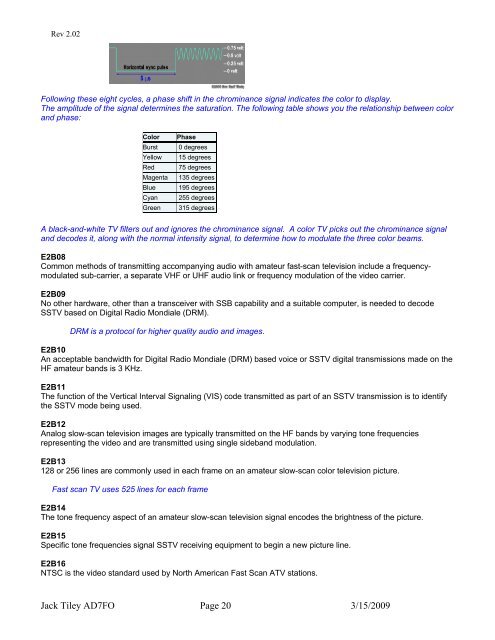Create successful ePaper yourself
Turn your PDF publications into a flip-book with our unique Google optimized e-Paper software.
Rev 2.02<br />
Following these eight cycles, a phase shift in the chrominance signal indicates the color to display.<br />
The amplitude of the signal determines the saturation. The following table shows you the relationship between color<br />
and phase:<br />
Color Phase<br />
Burst 0 degrees<br />
Yellow 15 degrees<br />
Red 75 degrees<br />
Magenta 135 degrees<br />
Blue 195 degrees<br />
Cyan 255 degrees<br />
Green 315 degrees<br />
A black-and-white TV filters out and ignores the chrominance signal. A color TV picks out the chrominance signal<br />
and decodes it, along with the normal intensity signal, to determine how to modulate the three color beams.<br />
E2B08<br />
Common methods of transmitting accompanying audio with amateur fast-scan television include a frequencymodulated<br />
sub-carrier, a separate VHF or UHF audio link or frequency modulation of the video carrier.<br />
E2B09<br />
No other hardware, other than a transceiver with SSB capability and a suitable computer, is needed to decode<br />
SSTV based on Digital Radio Mondiale (DRM).<br />
DRM is a protocol for higher quality audio and images.<br />
E2B10<br />
An acceptable bandwidth for Digital Radio Mondiale (DRM) based voice or SSTV digital transmissions made on the<br />
HF amateur bands is 3 KHz.<br />
E2B11<br />
The function of the Vertical Interval Signaling (VIS) code transmitted as part of an SSTV transmission is to identify<br />
the SSTV mode being used.<br />
E2B12<br />
Analog slow-scan television images are typically transmitted on the HF bands by varying tone frequencies<br />
representing the video and are transmitted using single sideband modulation.<br />
E2B13<br />
128 or 256 lines are commonly used in each frame on an amateur slow-scan color television picture.<br />
Fast scan TV uses 525 lines for each frame<br />
E2B14<br />
The tone frequency aspect of an amateur slow-scan television signal encodes the brightness of the picture.<br />
E2B15<br />
Specific tone frequencies signal SSTV receiving equipment to begin a new picture line.<br />
E2B16<br />
NTSC is the video standard used by North American Fast Scan ATV stations.<br />
Jack Tiley <strong>AD7FO</strong> Page 20 3/15/2009


